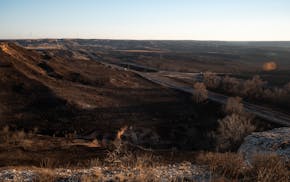With its goal of concurrently winding down coal power and boosting renewable energy, Xcel Energy is discovering that by the 2030s, it will need more "dispatchable" power than perhaps previously expected.
While Xcel tries to meet its aggressive goals for carbon-free power, the utility said in a regulatory filing Monday that in the early 2030s it may need to add the equivalent capacity of three sizable power plants. The reason: to better handle surges in power demand as variable energy sources — wind and solar — grow.
Dispatchable power is electricity that can be constant and turned on quickly. Xcel's future dispatchable needs could be met by large electricity-storing batteries or other new technologies. But they could also require the construction of more small gas plants.
Extremely cold weather last winter, combined with the increasing presence of variable renewable power, helped prompt Xcel to bolster its plans for future dispatchable power, the filing indicated.
The January polar vortex "really reinforced for us the importance of [ensuring] that the system serves customers every day, 24 hours a day," said Christopher Clark, Xcel's president for Minnesota and the Dakotas. "We want to make sure we have the reliability."
Minneapolis-based Xcel, the state's largest electricity provider, on Monday filed its "integrated resource plan" (IRP) with the Minnesota Public Utilities Commission (PUC). Electric utilities file an IRP every few years. The document outlines a utility's five-year and 15-year year plans. The PUC pays close attention to them.
Xcel unveiled the most dramatic parts of its latest IRP in May, topped by its plans to close two more coal-fired power plants and exit coal generation entirely by 2030. Also in May, Xcel announced plans for more than tripling its solar power production by 2030 and extending the life of its Monticello nuclear plant by at least a decade to 2040.
In Monday's filing, Xcel outlined plans for significantly increasing its energy-efficiency programs, which would reduce the need for some power production. And Xcel noted that between 2031 and 2034, it predicts adding about 1,700 megawatts of "cumulative firm dispatchable" power resources.
A megawatt is 1 million watts, and for an example of scale, Xcel's A.S. King coal plant in Bayport has a capacity of 511 megawatts.
The 1,700 megawatts of power in question would be needed for peak demand times. Currently, the main way to deal with those peak periods is by firing up smaller gas power plants. Over the next decade, "we think that could change," and that batteries or other technologies could "fill the gap," Clark said.
Still, it's also possible, he acknowledged, that Xcel could have to add more gas-fired resources.
Natural gas-fired generators emit about half as many greenhouse gases as those that burn coal, though environmental groups are leery of adding more gas instead of renewable energy like wind and solar.
Xcel plans to build a large 800-megawatt gas-fired plant in Becker, the site of its largest coal power plants. The Becker gas plant, which has already received state approval, would open in the mid-2020s.
Xcel's IRP filing noted that due to the variability of wind and solar generation, the company currently "encounters times" in which the difference between gross power demand and gross supply is tight.
"This is evident in extreme cases, such as the 2019 polar vortex [in late January] but also during normal winter operations like February 5, 2019, which was representative of conditions we typically experience throughout the winter season," Xcel said in Monday's filing. On that day, wind and solar together were producing only 6% of their capacity, dipping at certain hours to only 3%.
In the winter, solar capacity is diminished by the relative lack of sunlight, while wind turbines can be hampered by extreme cold. In the summer, wind-power volume can drop well below what's forecast for the grid if the wind largely stops blowing, the filing indicated.
Xcel's proposal to extend the life span of its Monticello nuclear plant is aimed retaining dispatchable, carbon-free power; nuclear plants run almost continuously. The company will ask the U.S. Nuclear Regulatory Commission (NRC) to re-license Monticello for another 10 years, with an option for 10 more years after that.
The Monticello plant and Xcel's two nuclear generators at Prairie Island were built in the early 1970s and re-licensed for another 20 years in the early 2010s. Monticello's current license expires in 2030, while Prairie Island's licenses last another three to four years after that.
The federal re-licensing process can take several years. "The time pressure is really there for Monticello," Clark said.
As for Prairie Island, Xcel appears to be keeping its options open. "We believe there is sufficient time to address the future of that plant in upcoming resource plans," Monday's filing said.
Xcel's electricity-generation mix in 2034 will look considerably different from in 2020, according to the plan filed Monday. In 2020, coal and wind should each account for 27% of the company's generation, while nuclear and natural gas will make up 25% and 13%, respectively. Solar is only 3%.
In 2034, wind would be the largest power source at 37%, followed by natural gas, nuclear and solar at 25%, 18% and 17% respectively.
Mike Hughlett • 612-673-7003

Room & Board transfers ownership to employees with stock plan
Stock market today: Wall Street falls sharply after dispiriting data on the economy, as Meta sinks
Congo questions Apple over knowledge of conflict minerals in its supply chain
Amazon cloud computing unit plans to invest $11 billion to build data center in northern Indiana

